John Edgerley | |
|---|---|
 Edgerley in 1840 | |
| Born | John Edgerley Circa 1814 Staffordshire, England |
| Died | 1849 Auckland, New Zealand |
| Scientific career | |
| Fields | Botany |
John Edgerley was a pioneering botanist in New Zealand.
John Edgerley | |
|---|---|
 Edgerley in 1840 | |
| Born | John Edgerley Circa 1814 Staffordshire, England |
| Died | 1849 Auckland, New Zealand |
| Scientific career | |
| Fields | Botany |
John Edgerley was a pioneering botanist in New Zealand.
John Edgerley was born about 1814, probably in Upper Arley, then Staffordshire England and worked as a gardener at Arley Hall. He migrated to New Zealand in 1834 on the sailing ship Emma Eugenia ex the Downs, arrived en route at Sydney on 10 May 1835 and reached the Hokianga 30 July. He spent the years to 1841 at Horeke in the Hokianga as gardener/botanist for Lieutenant Thomas McDonnell, who had been appointed an additional British Resident in New Zealand - they had travelled out together. He brought plants with him from England and when Edward Wakefield visited Horeke in 1839 he found a flourishing garden. There are records in England of John Edgerley sending plant specimens and live plants to Kew Gardens, Mr. A. B. Lambert and the Earl of Mountnorris. Auckland Museum has 8 letters written by John Edgerley to A B Lambert, J. Smith (curator at Kew) and Sir William Hooker concerned with the collecting of New Zealand plants for English collections, including “the royal gardens”. Subsequently, Edgerley returned to England with both live and dried plants and was at Arley Hall again in April 1842.
When John Edgerley sailed for England in 1842 he had taken back a collection of New Zealand plants for Kew Gardens. In return, the director of Kew, Sir William Hooker, undertook to provide him with a wide range of flowering shrubs (six casefuls) for setting up his nursery on this land in Epsom. Edgerley requested the following plants: “Rhododendrons, camellias, arbutus or strawberry tree, laurustine, Portugal laurel, common laurel, azaleas, a plant or two of lilac, wisteria sinensis, tree paeonia, with a few plants of fuchsias – corymbiflora if you can spare it, ribes sanguinea, magnolia grandiflora, deutzia scabra, box for hedging, with a few good roses, white moss if you can spare it, ajuga japonica, cedar of Lebanon, jasminum…acorns, chestnuts, hawthorn berries or any other seed you thought would germinate, also a small collection of good flower seeds with fir cones” . Although roses, flowering seeds and annuals had been imported by early missionaries, their planting concentrated on practical plants such as fruit trees, shelter trees and crops. Certainly this was the first importation of rhododendrums, camellias, azaleas, lilac and wisteria into New Zealand . He married Sarah Newnham at Upper Arley on 27 December 1842 and they travelled on the Tyne arriving at Hobart August 1843 then coming on to Auckland. It was possible that he leased some land immediately in the Epsom/Newmarket area as in the police census of 1844, he was living in a raupo hut in that location. John Edgerley brought a collection of items out with him including a set of blasting tools, candle snuffers, a tinder box and a humane man trap, these items are now in the Auckland War Memorial Museum.
A New Zealand Crown Grant, of land in the area now called Epsom, dated 21 December 1844 for 6 acres 2 roods was issued to John Kelly and Frederick Whitaker. This land was transferred to John Edgerley on 15 December 1851. On 10 June 1848 John Edgerley obtained a crown grant of 5 acres adjoining this Kelly/Whitaker grant.
At the land in Epsom, including the land now known as 74 and 66 Gillies Ave, he established a nursery which he worked till he died in 1849 at 35 years. By May 1846 he was advertising a large variety of fruit trees for sale, including a dozen varieties of apples at “Eden Nursery”. By 1848 he was advertising twenty four types of apple trees, six types of plum trees, twenty four types of cherry trees, four types of pear trees, five types of peach trees, seven types of nectarines and three types of apricot trees as well as a variety of other plants. Two uncommon shrubs bear Edgerley's name. Pomaderris prunifolia var. edgerleyi and Raukaua edgerleyi . Edgerley served as a judge at the first Agricultural and Horticultural Show, held on 18 December 1843 at Mr Hart's Exchange hotel.

John and Sarah had two boys, John born 26 July 1846 and William born 4 April 1848. A daughter Sarah was born in 1850. In 1852 Sarah Edgerley sold the fruit trees, put cows on the 11 acres and ran a milk supply.
John Edgerley's son, John, was one of the first white people born in Auckland in 1846. According to his own record he was born in the raupo hut on the land at Epsom. He was apprenticed to the building trade, serving in the Remuera and Parnell Volunteers during the land wars, then moved to the Thames gold fields, Fiji and Melbourne. In Fiji he built houses for Missionaries and ran a cotton plantation. He returned in to Epsom in the 1860s and in the early 1880s he went into partnership with his brother William, settling on the land at Epsom and running a building business. Around this time the brothers built a return villa on a high point of their property, incorporating John Edgerley's 1849 house according to family lore and Dinah Holman in “Newmarket lost and found”.
John's wife Sarah died in June 1895 aged 83. 1895 the Edgerley brother were conspicuous attenders at the annual meetings of Epsom ratepayers, usually held in William Edgerley's workshop. John Edgerley was elected to the Epsom Road Board in 1901 and served until April 1920.
In 1903 the Edgerley family sold the upper part of their land to George Goldsboro architect (now 66 Gillies Ave) for £196 and part to Alfred Kidd (now 74 Gillies Ave) for £180. Like Highwic, these properties were chosen because the building platforms, on land rising up the slopes of Mount Eden, had views across the valley and down to the harbour. Around this period, Mr Goldsboro built Mrs Wilson's house at 66 and Mr Kidd built a house at 74 to designs by Mr Goldsbro’. The entrances were from Domain Rd now called Gillies Avenue. The land must have been wooded with volcanic rock forest as there is the large stump of a mature pūriri tree under the Kidd house.
Around 1917, John and William Edgerley sold land to the south of the homestead to allow the Kidd family to extend their gardens . From 1926, the Edgerleys subdivided the property to the east of the homestead creating Edgerley Avenue from the drive to their house. John Edgerley Jr died on 1 October 1942 aged 97 in the house at 11 Edgerley Ave.
In 1942 the homestead was bought by AC Wood who commissioned the Californian architect A B Crocombe to renovate the property. This was done in the “modern American colonial style” and was featured in the New Zealand Institute of Architects ‘Home & Building’ magazine in 1944 as a good example of modernising a villa.
Although the outbuildings, a laundry, a workshop and a woodshed have been demolished the house remains exactly as re-designed in 1943.
Neither The Newmarket Heritage Study, (Report to Focus Newmarket group, Dinah Holman, February 1996) nor Historic Places Trust's submissions to Plan Change 196 make any mention of the Edgerley homestead. Under Plan Change 196, the zoning alters from 7a to 8c – highly intensive high-rise of up to six stories.
In July 2010 the Edgerley homestead was sold by A&C Shaw to Runcorn Hotel Development Corporation, a China-based development company, along with the former Carlton Bowling Club and the former garden of 74 Gillies Ave. The deal for the entire site was in the region of $22 million.
On 16 January 2011, in a telephone conversation with staff of Thresher Urban Design and Landscape Architecture, who have been contracted by Runcorn Hotel Development Corporation to assist them with their planning application, Paul Waite learns that their initial proposals do not include retention of any trees or historic buildings but Runcorn has proposed highly intense development of the site.
In 2011 a demolition permit was issued by Auckland Council for the Edgerley homestead.
Edgerley's granddaughter was Kate Edgerley, botanist and teacher. [1]
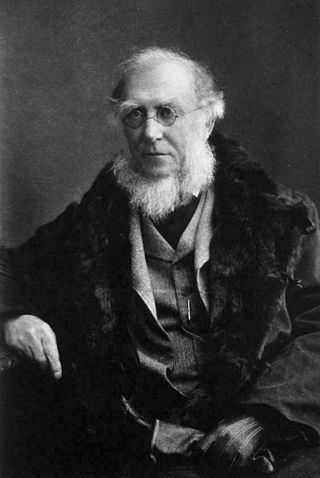
Sir Joseph Dalton Hooker was a British botanist and explorer in the 19th century. He was a founder of geographical botany and Charles Darwin's closest friend. For 20 years he served as director of the Royal Botanical Gardens, Kew, succeeding his father, William Jackson Hooker, and was awarded the highest honours of British science.
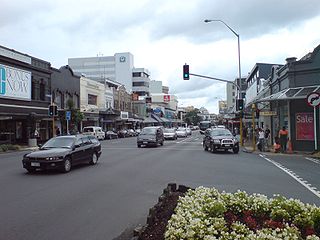
Newmarket is an Auckland suburb to the south-east of the central business district. With its high building density, especially of retail shops, it is considered New Zealand's premier retailing area, and a rival of local competitor Auckland CBD.
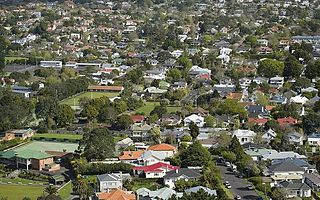
Epsom is a suburb of Auckland, New Zealand. It is located in the centre of the Auckland isthmus between Mount Eden and Greenlane, south of Newmarket, and five km south of Auckland CBD.

Mount Eden is a suburb in Auckland, New Zealand whose name honours George Eden, 1st Earl of Auckland. It is 4 kilometres (2.5 mi) south of the Central Business District (CBD). Mt Eden Road winds its way around the side of Mount Eden Domain and continues to weave back and forth as it descends into the valley; it runs south from Eden Terrace to Three Kings. Mt Eden village centre is located roughly between Valley Road and Grange Road. The domain is accessible on foot from many of the surrounding streets, and by vehicle from Mt Eden Road. The central focus of the suburb is Maungawhau / Mount Eden, a dormant volcano whose summit is the highest natural point on the Auckland isthmus.

Remuera is an affluent inner city suburb of Auckland, New Zealand. It is located four kilometres southeast of the city centre. Remuera is characterised by many large houses, often Edwardian or mid 20th century. A prime example of a "leafy" suburb, Remuera is noted for its quiet tree lined streets. The suburb has numerous green spaces, most obvious of which is Ōhinerau / Mount Hobson – a volcanic cone with views from the top overlooking Waitematā Harbour and Rangitoto.

Leonard Cockayne is regarded as New Zealand's greatest botanist and a founder of modern science in New Zealand.
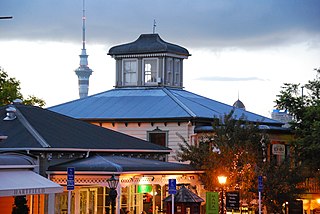
Parnell is a suburb of Auckland, New Zealand. It is one of New Zealand's most affluent suburbs, consistently ranked within the top three wealthiest, and is often billed as Auckland's "oldest suburb" since it dates from the earliest days of the European settlement of Auckland in 1841. It is characterised by its mix of tree lined streets with large estates; redeveloped industrial zones with Edwardian town houses and 1920s bay villas; and its hilly topography that allows for views of the port, the Waitematā Harbour, Rangitoto Island and the Auckland Domain. To its west lies the Auckland Domain, to the south Newmarket, and to the north the Ports of Auckland.
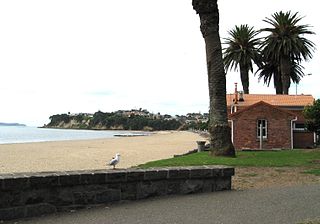
Saint Heliers is an affluent seaside suburb of Auckland with a population of 11,520 as of June 2022. This suburb is popular amongst visitors for the beaches, cafés, and views of Rangitoto Island, the distinctive volcanic island in the Hauraki Gulf.

James Drummond was an Australian botanist and naturalist who was an early settler in Western Australia.

Ulmus × hollandica 'Major' is a distinctive cultivar that in England came to be known specifically as theDutch Elm, although all naturally occurring Field Elm Ulmus minor × Wych Elm U. glabra hybrids are loosely termed 'Dutch elm'. It is also known by the cultivar name 'Hollandica'. Nellie Bancroft considered 'Major' either an F2 hybrid or a backcrossing with one of its parents.

George Augustus Selwyn was the first Anglican Bishop of New Zealand. He was Bishop of New Zealand from 1841 to 1869. His diocese was then subdivided and Selwyn was Metropolitan of New Zealand from 1858 to 1868. Returning to Britain, Selwyn served as Bishop of Lichfield from 1868 to 1878.

Ulmus 'Louis van Houtte' is believed to have been first cultivated in Ghent, Belgium circa 1863. It was first mentioned by Franz Deegen in 1886. It was once thought a cultivar of English Elm Ulmus minor 'Atinia', though this derivation has long been questioned; W. J. Bean called it "an elm of uncertain status". Its dissimilarity from the type and its Belgian provenance make the 'Atinia' attribution unlikely. Fontaine (1968) considered it probably a form of U. × hollandica.
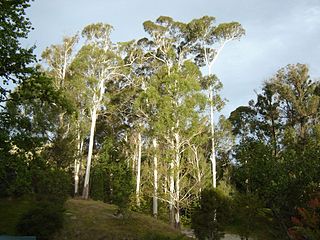
Eastwoodhill is the national arboretum of New Zealand. It covers 131 hectares (1.31 km2) and is located 35 km northwest of Gisborne, in the hill country of Ngatapa. It was founded in 1910 by William Douglas Cook. Cook's life work would become the creation of a giant collection of Northern Hemisphere temperate climate zone trees in New Zealand – a dream that would eventually cost him all his money – buying and importing thousands of trees from New Zealand and British nurseries.
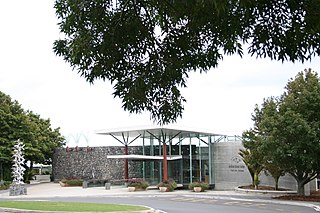
Auckland Botanic Gardens is a botanical garden in the New Zealand city of Auckland. It is located in the suburb of Manurewa, in the Manurewa Local Board Area. The gardens cover 64 hectares, and holds more than 10,000 plants.
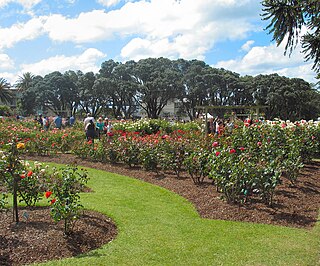
Dove-Myer Robinson Park, more commonly known as the Parnell Rose Garden, is a park in Parnell, Auckland, New Zealand. The park is named after Dove-Myer Robinson, the longest-serving mayor of Auckland, who served for 18 years. There are over 5,000 roses in the garden. Some of the plants in the garden have been bred by internationally celebrated rose breeders.

Ohinetahi is a valley, historic homestead, and formal garden on Teddington Road, Governors Bay, Christchurch, Canterbury region, New Zealand. Ohinetahi valley is situated at the head of Lyttelton Harbour, at the base of the Port Hills. While the Ohinetahi Homestead is considered to be a significant historic building in the small settlement of Governors Bay, the formal garden of Ohinetahi is considered to be one of New Zealand's finest. Amongst the early owners of Ohinetahi were Canterbury pioneer William Sefton Moorhouse and Thomas Potts, New Zealand's first conservationist. Sir Miles Warren, architect of the Christchurch Town Hall, was the last private owner, and gifted it to New Zealand.
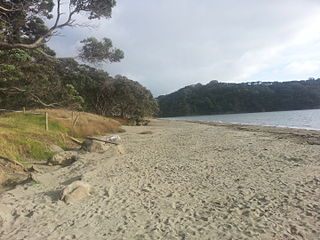
Wenderholm Regional Park is a regional park north of Auckland in New Zealand's North Island. It is situated between the estuaries of the Puhoi River and the Waiwera River, on the east coast of New Zealand's North Island and features a homestead known as Couldrey House, and a carved pouwhenua.
George Selwyn Goldsbro’ was the son of Dr. Charles Field Goldsboro, who had emigrated to New Zealand in 1860, serving as a surgeon during the New Zealand Wars. Charles Goldsboro finished his medical degree at Sydney University in 1868 and returned to Auckland, where his son George was born in 1870.

Greenwoods Corner is an Auckland neighbourhood located within the suburb of Epsom, situated to the south of Newmarket and to the north of Royal Oak, at the intersection of Pah Road and Manukau Road. It is settled in the lee of Maungakiekie / One Tree Hill and serves as a convenient launching point for the area's many attractions. Cornwall Park with Maungakiekie and the Stardome Observatory, Alexandra Park with its harness-racing track, and Monte Cecilia Park with the Pah Homestead and TSB Bank Wallace Arts Centre are all a convenient distance from Greenwoods Corner.

The Flora Antarctica, or formally and correctly The Botany of the Antarctic Voyage of H.M. Discovery Ships Erebus and Terror in the years 1839–1843, under the Command of Captain Sir James Clark Ross, is a description of the many plants discovered on the Ross expedition, which visited islands off the coast of the Antarctic continent, with a summary of the expedition itself, written by the British botanist Joseph Dalton Hooker and published in parts between 1844 and 1859 by Reeve Brothers in London. Hooker sailed on HMS Erebus as assistant surgeon.